Author:
Lewis Jackson
Date Of Creation:
10 May 2021
Update Date:
1 July 2024

Content
To add or subtract fractions with different denominators, you must first find the least common denominator between them. This is the smallest common multiple of each of the initial denominators in the equation, or the smallest integer that can be divided by each denominator. Identifying the smallest common denominator allows you to convert denominators to the same number so that you can add and subtract them.
Steps
Method 1 of 4: List Multiples
List the multiples of each denominator. List a few multiples for each denominator in the equation. Each list should contain products for which the denominator is multiplied by 1, 2, 3, 4, and so on.
- Example: 1/2 + 1/3 + 1/5
- Multiples of 2: 2 * 1 = 2; 2 * 2 = 4; 2 * 3 = 6; 2 * 4 = 8; 2 * 5 = 10; 2 * 6 = 12; 2 * 7 = 14; etc.
- Multiples of 3: 3 * 1 = 3; 3 * 2 = 6; 3 * 3 = 9; 3 * 4 = 12; 3 * 5 = 15; 3 * 6 = 18; 3 * 7 = 21; etc.
- Multiples of 5: 5 * 1 = 5; 5 * 2 = 10; 5 * 3 = 15; 5 * 4 = 20; 5 * 5 = 25; 5 * 6 = 30; 5 * 7 = 35; etc.
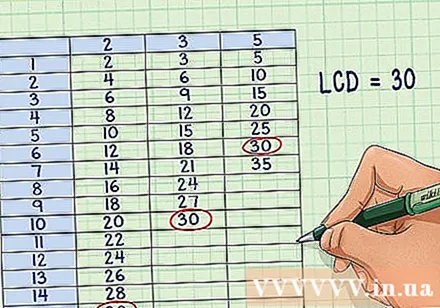
Determine the smallest common multiple. Go through each list and highlight any multiples that are common among all the original denominators. After determining the common multiples, find the smallest denominator.- Note that if you still can't find the common denominator, you may have to keep writing multiples until you reach the common multiple.
- This method is easier to use when the denominator is small numbers.
- In this example, the denominators have only one multiple of 30: 2 * 15 = 30; 3 * 10 = 30; 5 * 6 = 30
- So the minimum common denominator = 30
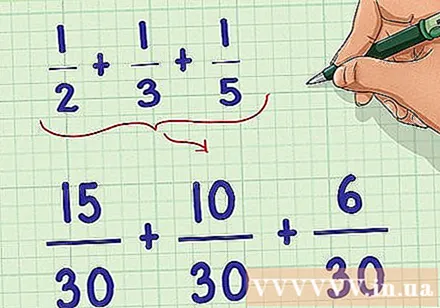
Rewrite the original equation. To swap each fraction in the equation so that the fraction value does not change, you will need to multiply the numerator and denominator by the same factor that you used to multiply the corresponding denominator when finding the least common denominator. .- For example: (15/15) * (1/2); (10/10) * (1/3); (6/6) * (1/5)
- New equation: 15/30 + 10/30 + 6/30

Solve the rewritten problem. After finding the smallest common denominator and changing the corresponding fractions, you can solve the problem with no difficulty. Remember to simplify the fraction in the last step.- Example: 15/30 + 10/30 + 6/30 = 31/30 = 1 1/30
Method 2 of 4: Using the Largest Common Factor
List all the factors for each denominator. Factors of a number are all integers that the number is divisible by.The number 6 has four factors: 6, 3, 2, and 1. Every number has a factor of 1 because 1 multiplied by any number equals the same number.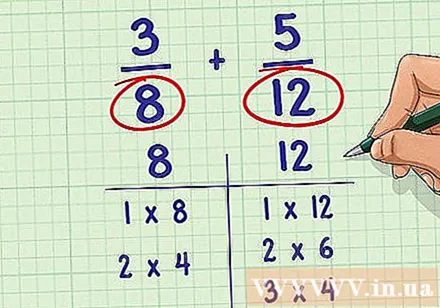
- Example: 3/8 + 5/12.
- Factors of 8: 1, 2, 4, and 8
- Factors of 12: 1, 2, 3, 4, 6, 12
Determine the greatest common factor between the two denominators. After listing all the factors for each denominator, circle all the factors that are common. The largest common factor is the factor that will be used to solve the problem.
- In this example, 8 and 12 have the common factors 1, 2, and 4.
- The maximum common factor is 4.
Multiply the denominators together. To use the greatest common factor to solve a problem, you must first multiply the two denominators together.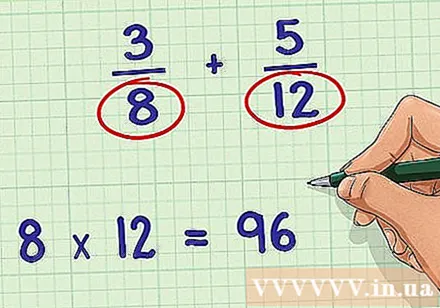
- In this example: 8 * 12 = 96
Divide the result obtained by the largest common factor. After finding the product of the two denominators, divide that product by the greatest common factor in the previous step. This number is your least common denominator.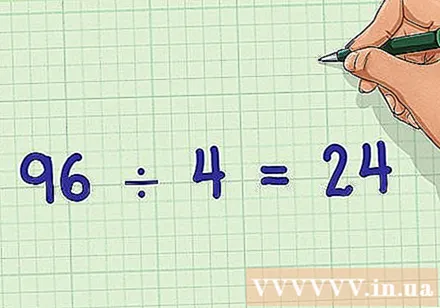
- Example: 96/4 = 24
Divide the lowest common denominator by the original denominator. To find the factor that multiplies the denominators equally, divide the smallest common denominator you have found by the original denominator. Multiply the numerator and denominator of each fraction by this number. The hour denominators will be equal to the least common denominator.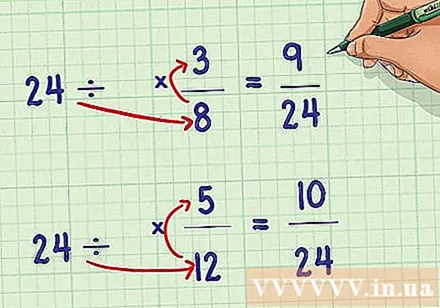
- For example: August 24 = 3; December 24 = 2
- (3/3) * (3/8) = 9/24; (2/2) * (5/12) = 10/24
- 9/24 + 10/24
Solve rewritten equations. With the smallest common denominator you find, you can add and subtract fractions in an equation with no difficulty. Remember to reduce the fraction in the final result, if possible.
- Example: 9/24 + 10/24 = 19/24
Method 3 of 4: Analyzing Each Denominator Product of Prime Factors
Split each denominator into prime numbers. Analyze each prime factor product denominator. A prime number is a number that cannot be divided by any number other than 1 and itself.
- For example: 1/4 + 1/5 + 1/12
- Parsing 4 into prime numbers: 2 * 2
- Decomposing 5 into prime numbers: 5
- Decomposition 12 into prime numbers: 2 * 2 * 3
Counts the number of occurrences of each prime number. Calculate the total number of times each prime number occurs in each product.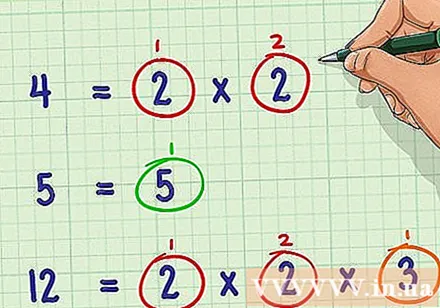
- Example: There are 2 numbers 2 in 4; there is no 2 in 5; 2 numbers 2 in 12
- There is no 3 in 4 and 5; a number 3 in 12
- There is no 5 in 4 and 12; a number 5 out of 5
Get the most occurrences of each prime number. Determine the number of times each prime number occurs at most and record that number.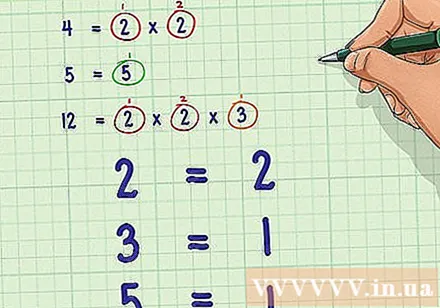
- Example: Most occurrences of 2 is two; of the 3 Is one; of the 5 Is one
Write that prime number equal to the number of times you counted in the step above. Write only the number of times they appear in the denominator, not all of them.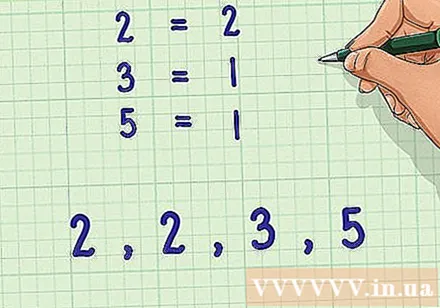
- Example: 2, 2, 3, 5
Multiply all the prime numbers in this sequence. Multiply the prime numbers we wrote in the previous step. The product obtained is the least common denominator.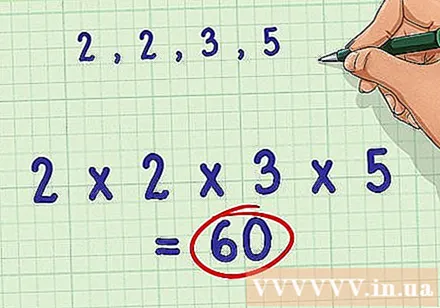
- Example: 2 * 2 * 3 * 5 = 60
- Minimum common denominator = 60
Divide the lowest common denominator by the original denominator. To find the factor that multiplies the denominators equally, divide the smallest common denominator you have found by the original denominator. Multiply the numerator and denominator of each fraction by this number. The hour denominators will be equal to the least common denominator.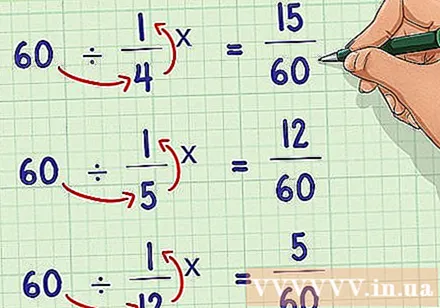
- For example: 60/4 = 15; 60/5 = 12; 60/12 = 5
- 15 * (1/4) = 15/60; 12 * (1/5) = 12/60; 5 * (1/12) = 5/60
- 15/60 + 12/60 + 5/60
Solve rewritten equations. With the smallest common denominator you find, you can add and subtract fractions as usual. Remember to reduce the fraction in the final result, if possible.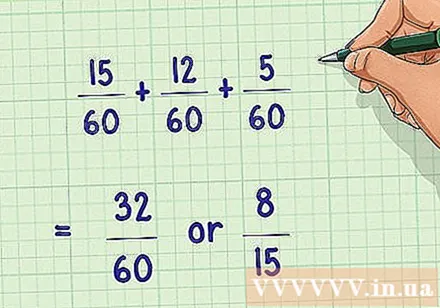
- For example, 15/60 + 12/60 + 5/60 = 32/60 = 8/15
Method 4 of 4: Working with Whole Numbers and Mixed Numbers
Converts each integer and mixed number into an irregular fraction. Converts mixed numbers into irregular fractions by multiplying the whole number by the denominator and adding the numerator to the product. Converts the whole number to an irregular fraction by placing it above the denominator "1".
- Example: 8 + 2 1/4 + 2/3
- 8 = 8/1
- 2 1/4; 2 * 4 + 1 = 8 + 1 = 9; 9/4
- The rewrite equation: 8/1 + 9/4 + 2/3
Find the smallest common denominator. Use any of the methods above to find the lowest common denominator. Note that, in this example we will use the “list multiples” approach, where a list of the multiples of each denominator is listed and the least common denominator is determined from these lists.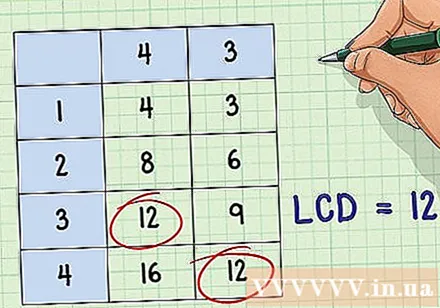
- Note that you do not need to list a given multiple 1 for any number multiplied by 1 also by itself; In other words, all numbers are multiples of 1.
- For example: 4 * 1 = 4; 4 * 2 = 8; 4 * 3 = 12; 4 * 4 = 16; etc.
- 3 * 1 = 3; 3 * 2 = 6; 3 * 3 = 9; 3 * 4 = 12; etc.
- Minimum common denominator = 12
Rewrite the original equation. Without multiplying by yourself the denominator, you must multiply the entire fraction by the number needed to convert the original denominator to the smallest common denominator.
- For example: (12/12) * (8/1) = 96/12; (3/3) * (9/4) = 27/12; (4/4) * (2/3) = 8/12
- 96/12 + 27/12 + 8/12
Solve the equation. With the smallest common denominator found and the original equation converted to the smallest common denominator, you can add and subtract fractions with no difficulty. Remember to simplify the fraction in the final result, if possible.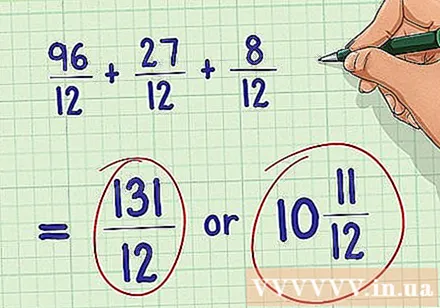
- For example: 96/12 + 27/12 + 8/12 = 131/12 = 10 11/12
What you need
- Pencil
- Paper
- Calculator (optional)
- Ruler



